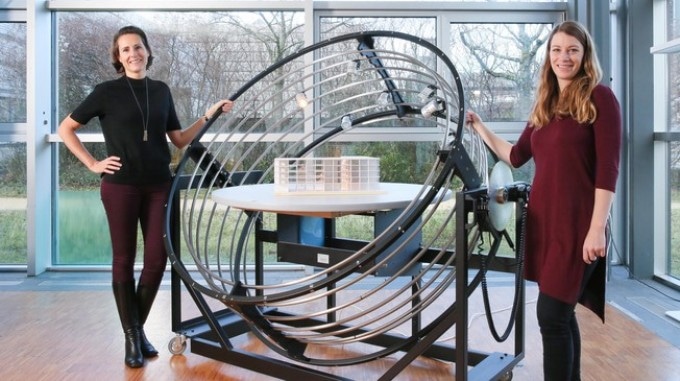Dec 21 2017
 Marilyne Andersen, EPFL professor and Siobhan Rockcastle, who just achieved a postdoc at Laboratory of lntegrated Performance in Design, are the developers of OCUVIS. CREDIT: 2017 Alain Herzog.
Marilyne Andersen, EPFL professor and Siobhan Rockcastle, who just achieved a postdoc at Laboratory of lntegrated Performance in Design, are the developers of OCUVIS. CREDIT: 2017 Alain Herzog.
OCUVIS, a visualization software created by an EPFL spin-off proposed to be launched shortly, enables architects to replicate 3D models of buildings to evaluate the performance of natural light inside the buildings. Upon designating the ambient conditions, architects can observe the visual and non-visual properties of the ensuing natural light in their models.
The architecture of a building should be modelled so as to tap the benefits of the manner in which natural light changes based on the season and time of the day. Although daylight can be viewed in a given space, the spectrum, intensity, and angle of sunlight can have an impact on the occupants of the building in ways that are tough to expect and in ways the occupants might not even know about. For example, the intensity and composition of light can at times have a soothing impact. Although at other times, it can have an alerting effect due to the secretion of hormones activated by the retina. OCULIGHT Dynamics, a soon-to-be-launched EPFL spin-off, has applied the outcomes of a study concluded at EPFL to quantify the impacts and to develop distinctive, thorough expertise in this field. Recently, the spin-off put its knowledge to good use to create a path-breaking web visualization software that allows architects to anticipate the way daylight will affect the building occupants depending upon three criteria: comfort, with regards to glare avoidance; and emotion, with regards to the spatial composition and fluctuations of light; vitality, with regards to non-visual light exposure over the course of a day.
Simulating natural light from the occupants’ perspective
The technique starts with the making of a 3D computer model of a proposed building and its geographic location. Using this, the architect can identify the ambient weather conditions and observe the way in which the ensuing daylight will be viewed by occupants of the building at eye level from a number of points inside the building. An architect can use OCUVIS to calculate and visualize the outcomes to alter the settings based on time of the day or year, sky condition, and position within the building and perceive the way sunlight’s dynamics, weather, and space affect the well-being of the occupants across a number of factors.
At every point inside the building, a cluster of arrows – each representing a viewpoint direction from a given spot – appear in distinct colors to specify whether the natural light at that location will lead to calm mood or excitement, whether there is a probability of visual unease, or whether it presents a long-term health risk. For instance, the natural light at a particular location might be energetic, vibrant, and favorable for the health of an occupant if he or she is looking toward a window, yet have the opposite impact if the occupant is positioned with his or her back facing the window or if it is a grey winter day. Architects can put information such as this to good use to enhance their building models to improve the visual comfort and well-being of the occupants. Certainly, the optimal daylight design for a specified space is also dependent on the way the space is used by its occupants.
A new type of receptor attuned to circadian rhythms
Three scientists from EPFL’s Interdisciplinary Laboratory of Performance-Integrated Design (LIPID) collaborated to design the visualization platform and computational models specifying the unrevealed performance factors – and to launch their new business, OCULIGHT Dynamics. The upcoming company will be providing expert, pioneering consulting services offered by its three founders—Marilyne Andersen, an EPFL professor and head of LIPID; and Siobhan Rockcastle and Maria Amundadottir, who both completed their PhDs at LIPID. Rockcastle is now a tenure-track professor in the University of Oregon, United States, and Amundadottir is a research engineer in Iceland.
The models adopted to quantify the properties evaluated by their software have been reported in various journal articles and two dissertations. A paper published in one of the journals elucidated the way humans discern distinct lighting environments. The outcomes of the research were used “to determine what percentage of people would consider a given environment calm or exciting based on the lighting composition,” stated Rockcastle. The responses of participants who took part in the research were used to create an algorithm that is adopted as a prediction model for the OCUVIS software.
The non-visual properties of light, which are less known to majority of the people, have been discovered to have a quantifiable impact on various aspects of people’s health.
It wasn’t too long ago that scientists discovered a new type of photoreceptor, called ipRGCs, in the human eye. These receptors regulate our internal clock to the external light dark cycle and respond directly to bright light, impacting alertness and wellbeing.
Maria Amundadottir, Research Engineer, Iceland
Studies have demonstrated that properties that greatly affect our non-visual system include the light’s intensity, exposure timing, and spectral distribution, or the color (for example, blue light is highly effective).
The three EPFL scientists acquired a Venture Grant from the InnoSeed ENAC program that also funded the important development steps of their visualization software, which has been already published online. These stages involved developing features that enabled architects to interactively visualize the impact of light on well-being of occupants in a given space, to compare distinct design options and performance measures, and to assess their designs against relevant lighting standards. In general, it enables architects to include well-being-associated factors such as occupant comfort, health, and emotion alongside traditional assessment criteria.